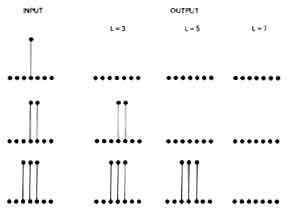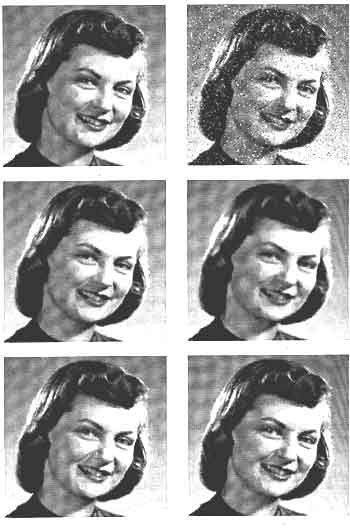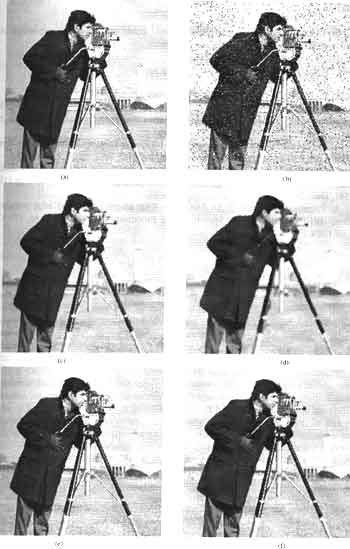| GISdevelopment.net ---> AARS ---> ACRS 1997 ---> Digital Image Processing |
Adaptive Multi-Shell Mdian
Filter for Improving Image Quality
Narupon Panakulchaiwit,
Danai Lisaw Atdiratanakul, Kobachai Dejhan and Fusak
Cheevasuvit
Faculty of Engineering,
King Mongkut's Institute of Technology Ladkrabang, Ladkrabang,
Bangkok 10520, Thailand
Tel : 66-2-3269967, 66-2-3269081, Fax : 66-2-3269086
Email :mailto:kobachai@telelan.telecom.eng.kmitl.ac.th
Chatcharin Soonyeekan
Faculty of Engineering,
Kasem Bundit University, Pattankaran Road,
Bangkok 10520, Thailand
Abstract Faculty of Engineering,
King Mongkut's Institute of Technology Ladkrabang, Ladkrabang,
Bangkok 10520, Thailand
Tel : 66-2-3269967, 66-2-3269081, Fax : 66-2-3269086
Email :mailto:kobachai@telelan.telecom.eng.kmitl.ac.th
Chatcharin Soonyeekan
Faculty of Engineering,
Kasem Bundit University, Pattankaran Road,
Bangkok 10520, Thailand
To display the images is difficult, the main problem is the impulse noise (or salt and pepper noise). This paper proposes two algorithms to improve the impulse noise for obtaining the better image quality than the regular method (or fixed length) median filters when the images are corrupted by impulse noise. The advantages of this algorithm is easy to implement, when realized for hardware implementation and the additional circuits are rather simple. Furthermore, the algorithms can easily be integrated into efficient hardware realizations for median filers. The performance of proposed filters can be compared with regular median filters (fixed length or standard median filters for window size 3x3).
Introduction
The two-dimensional median can eliminate the impulse noise without the loss of edge information [1],but it is difficult to maintain the picture details, especially the small window such as 3x3. This condition is really for any amount of impulse noise, thus it is a disadvantage of 3x3 windows. This paper investigates to use 5 x 5 windows and it reduced the effect of discrete impulse noise on an image. The disadvantage results in blurred edged are increased for the higher window. Many techniques have previously proposed [2-5].
This paper investigates two algorithm of two-dimensional median filter. The first is 3x3 multi-shell constant window, it is good for image noise smoothing and sharp step edges is small amount of impulse noise. The second is the automatically adjustable window size. It improves any problem of constant window and give the low blurred edges with high sharp. It can be used for the case of any amount of impulse noise.
Theory
The salt and pepper noise has gray level with higher low that is different from the neighborhood point with a short time. It is obviously to see, thus the disturbance model can be carried out as follows;
Sij = gray level of original image at point (i,j)
Xij = gray level of disturbanced image at point (i,j)
n = noise signal level
Xij = Sij for the probability is (1-p)
Xij = Sij + n for the probability is p
P = probability of disturbance
n has uniform disturbution; 0<n<(255-Sij) for salt noise and -Sij<n<0 for pepper noise.
The experimental image has the gray level between 0 to 255. Therefore, the salt noise ha the maximum not more tan 255, for the pepper noise has the minimum value equal to 0. In the experiment will use both of the noises for the same time.
Multi-shell median filter
This method is proposed to solve the blur of image. Considering the median of set of number for one-dimensional as in equation (1)
a2 will be considered and {a1, a3} are the neighbors around a2. The two-dimensional of 3 x 3 window can be carried out, at the center of the window, the central sample will be considered as in equation (2).
Given Ym,n is output of multi-shell median filter at point m, n and am,n is the data at the center of the considered window. S1m,n is the set of the called the first shell or the set of data around the center of window at point am,n as show in Fig. 1.

Fig. 1 First shell for 3 x 3 window.
The output of the multi-shell median filter is defined by;
The equation (3) shows the considered sample and it is isolated impulse or the large difference from the neighbor around the considered point. It is separated from the group and substituted by the minimum of maximum of the first shell. The output equation depends on the considered central sample. It means that the center of the window keeps the status of median filtering output.
It is obviously that the multi-shell median filter can filter the salt or pepper noise for 1 pixel. For the impulse has more than 1 pixel, it is difficult to filter. It can maintain the salt and pepper noise and this picture is not so good.
The results are shown in Fig. 3(e) which has the higher sharp when compared with the 3x3 constant window.
Automatically adjustable window size.
Fig. 2 shows the ability to eliminate noise by using median filtering for the various length (L) of the windows.

Fig. 2 Various length of the window to compare the ability filtering the noise.
From Fig. 2 the length of the window con be made to decide for the suitable window by examining the number of point of the noise. The process is to examine for the horizontal and vertical window size. The first procedure is to examine the window length for horizontal window size (Lh) and find out the window length for vertical window size (Lv). Having finished both processed, it is necessary to arrange the data. Suppose that the set of P and Q are the difference of gray level of picture for various point of the window. After that to find the threshold level for testing P and Q, the threshold level is between 16 to 48 for each picture. The procedure for pepper noise and salt noise are he same, except the sign for P and Q is opposite.
In Fig. 3(a) is original picture for 256 x 256 pixel, this picture is distributed by 5% of salt and pepper noise . Fig. 3(b) and 3(c) show the results from the 3x3 constant window median filtering. Fig. 3(e) shows the result after using the multi-shell median filtering. Fig. 3 (f) is the result after using the automatically adjustable window size.
The testing results have also carried out by using the other picture as shown in Fig. 4 corresponding to Fig. 3.

Fig. 3 (a) original picture 256 x 256 pixels, (b) disturbed by 5% salt and pepper noise, (c) filtered picture using 3 x 3 constant window, (d) filtered picture using 5 x 5 constant window, (e) filtered picture using multi-shell median filter, (f) filtered picture using automatically adjustable window size.

Fig. 4 Testing picture cameral man
Conclusion
Two algorithms have been investigated. Each technique as advantage and disadvantage when compared with the results.
References
- W. K. Pratt, Digital image processing, Wiley-Interscience, 1978.
- T. S. Huang, G. J. Yang and G. T. Tang, "A fast two-dimensional median filtering algorithm, " IEEE Trans. Acoust, Speech , Signal Processing, vol. ASSP-27, no. 1, pp. 13-18, Feb. 1979.
- P. M. Narendra, "A separable median filter for image noise smoothing," IEE Trans. Pattern Analysis and Machine Intelligence, vol. PAMI-3, no. 1, pp. 20-29, Jan. 1981.
- N.C. Gallagher Jr. and G. L. Wise, "A theoretical analysis of the properties of median filters, " IEEE Trans. Acoust, Speech, Signal Proceesing, vol. ASSP-29, no. 6, pp. 1136-1141, Dec. 1981.
- C. A. Pornalaza-Raez and C. D. McGillem, "An adaptive nonlinear edge proceesing filter," IEEE Trans. Acoust., Speech, Signal Proceesing, vol. ASSP-32, pp. 571-576, June 1984.